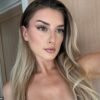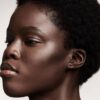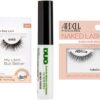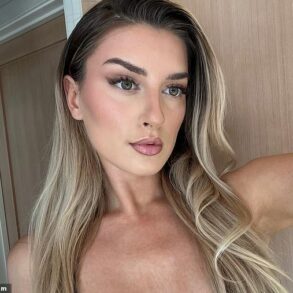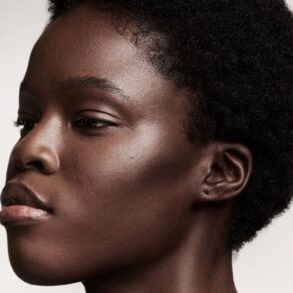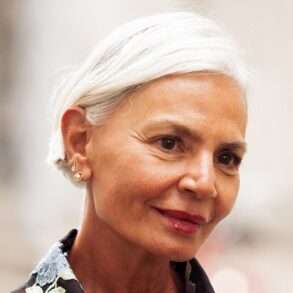
It’s 7 a.m. and I’m scrolling, blurry eyed, through my phone in an effort to wake up. “Under-eye concealer is dead,” a TikToker tells me. I nearly spit out my morning cup of tea. Concealer… Is… Dead? Am I having a nightmare? I quickly switch to my front camera and inspect my face. Dark circles look back at me, looming with such force that I reflexively begin prodding and stretching my skin until they temporarily ease. Ultimately, it’s no use. I am, in fact, naturally blessed with much bigger shadows than any of the gorgeous, concealer-eschewing women I see on TikTok. Most of whom are white or white-passing.
As a beauty writer, I’m often asked to share my desert-island product, and my answer is always the same: Huda Beauty #FauxFilter Concealer in Cookie Dough. Concealer is the one product that I simply cannot live without. Dabs of the coverage product under my eyes and on my post-acne hyperpigmentation go a long way, boosting my confidence and uniforming my skin tone in a way that no other product can. I know a lot of my fellow brown girls feel this way. It’s unsurprising considering that studies show periorbital hyperpigmentation (hereditary dark circles) is most common among South Asians. Then, of course, there’s the fact that they’re genetic in over 60% of cases. This makes them unlikely to go away with creams or better lifestyle habits like drinking more water or getting a restful night’s sleep.
Like with the Scandi hairline and “clean girl” aesthetic, this under-eye concealer trend is spearheaded by white TikTok users, and it suggests that under-eye concealer is a thing of the past. Instead, people are opting to embrace their natural shadows — a far cry from the lashings of concealer used in 2016 trends, which favored a full beat.
Aarti Pal, award-winning makeup artist and founder of South Asian Beauty Collective, says these heavy 2016-era trends are perhaps what caused today’s less-is-more approach. “This trend likely emerged as a counter-movement to the heavily made-up looks popularized by social media in the past,” she explains. “It aligns with the growing emphasis on skincare, self-care and mental wellbeing, as well as a broader cultural shift towards authenticity and minimalism.” Beauty journalist and author Anita Bhagwandas adds that it’s a reaction to the super-filtered, perfected, overly filled look of recent years. “People are fed-up of that, and I think that’s a good thing because it means we are seeing a movement towards embracing ‘real’ skin and ‘real’ skin texture.”
This shift is easy to see; search for “no makeup” on TikTok and a huge 215.5 million posts will pop up. TikTok has given a platform to the average person — as well as makeup artists and professionals — blurring the lines between expert and amateur trend forecasting. On the one hand, I’m here for people embracing their natural shadows and “imperfections”. On the other hand, I’m painfully aware that this doesn’t feel like an option for many people of color. It seems to me like this trend is just another way to favor the “naturally pretty” in terms of Western beauty ideals.
On young, white women, dark circles are deemed “cool” or “edgy”, with some even drawing them on. For brown women, though, it feels like a completely different story. I recently stumbled across an old video of fashion, beauty and lifestyle TikToker Gazelle (@Ghazalafaq2), that showed her personal under-eye concealing technique. On one eye, she began with absolutely no makeup on, and one of the top comments was, “Girl, did you darken your eyes before this?” The comment got over 800 likes, and shows the sheer ignorance that people can have when it comes to what brown girls really look like. We don’t look like the West’s idea of “perfect”. We have pigmentation and dark circles; our acne scars are obvious; we don’t always get cute freckles in the sun.
@ghazalafaq2 My under eye concealer routine for concealing very dark circles without it looking cakey! @Lancôme @NARS Cosmetics @IL MAKIAGE #undereyecircles #darkcircles #undereyeconcealer #undereyeconcealertips #darkcircles #concealerroutine #concealertutorial #fyp #viral ♬ original sound – Gazelle co | beauty tips
It’s also worth noting that 80% of TikTok creators are under 25, which is before you begin to experience the signs of aging on skin. This concealer-denouncing movement not only excludes women of color, but tired moms with babies and those with mature skin. Not to mention it completely clashes with trends adored by the Black community. Aesthetician and beauty content creator Alicia Lartey says that the anti-concealer trend is exclusionary, adding that it doesn’t take into account the UK Black girl makeup scene, which features bright concealer right under the eyes. “I am yet to understand why it is some form of a brag to say that you do not need concealer,” she adds. “When things trend in beauty, there is a particular ‘look’ that comes attached to the virality — and it’s not diverse.”
Take the the “French girl” aesthetic, for example, which has been canonized on social media. This aesthetic idealizes women who don’t wear a lot of makeup; who are youthful and hedonistic. They party all night and crawl into bed at 6 a.m. before heading to work with smudged mascara still clinging on from the night before. The French girl doesn’t try. She’s effortless. The French girl is white. The French girl’s dark circles are cool.
For many people of color, however, dark circles are a source of shame or embarrassment. Aliyah*, 27 and of North African descent, tells me, “This trend is a no from me. I need concealer as the bare minimum. My dark circles are literally purple, and I know if I go to work without concealer everyone will be like, ‘Honey, are you okay?’” It seems, then, that white people forget that women of color come ready-made looking different to them, and that it’s normal for us all to have different features. This ingrained point of view comes as no surprise, considering the standardization of Western culture and beauty ideals in mass media go as far back as the 1920s, way before TikTok and Instagram existed.
It’s a problem to this day, and it leaves us melanated folk open to comments that can affect our confidence forever. “I once got asked if [the darkness] was due to an injury, and it’s stuck in my head,” says Aliyah, who explained that she wasn’t always so self-conscious of the dark skin around her eyes. Rather, she became conscious after this encounter. Interestingly, “pretty privilege” (where systemic biases on perceived attractiveness affect how you’re treated) also comes into play. “I feel like people are nicer to me when I don’t have dark circles,” Aliyah admits, “to the point where I’ll put makeup on specifically to do things. If I go and get my hair done, I always get better results if I have makeup on; they take my opinion more seriously. I also think I win arguments easier if I look ‘pretty’. I feel like people sympathize more with pretty, cute, well-rested-looking women.”
But it’s not all doom and gloom; Pal thinks that the no concealer trend “supports the idea that all skin types and tones should be celebrated as they are”, though she does acknowledge that it also inadvertently favors those with naturally clear skin. For some, this trend is an opportunity to celebrate their heritage. “As a woman of color, specifically Eritrean, Ethiopian and East African, I see my dark circles as part of my own beauty,” says makeup artist Delina Medhin. Bhagwandas shares a similar sentiment, suggesting that previous, makeup-heavy trends made South Asians feel like they had to cover up to fit in. “Dark circles are a part of our natural heritage, and who says that’s a bad thing?”, she questions.
In my personal opinion, this pressure is still there, it’s just that we now feel pressured to fit in without the added help of a concealer. “On the flip-side of this,” Bhagwandas notes, “I don’t think anyone should be ‘told’ not to use concealer. It should come down to personal choice,” she tells me. “I just hope that this trend will help women of color to embrace the different nuances and tones within their skin.”
Perhaps the trick is to find a comfortable middle ground. Ruby Hammer MBE is a makeup artist who’s well-known among the South Asian community. She suggests using a “light-handed approach” with concealer to get the look of no product without actually baring your dark circles (if you don’t want to) or foregoing concealer completely (if you’re not comfortable). “Instead of applying large triangles under the eyes, opt for a little bit in the inner and outer corners and, if [you think] more is needed, apply on the edge of the socket so that you can blend it upwards. If this doesn’t feel like enough, add a color corrector.” Hammer corrects pigmentation with Charlotte Tilbury Magic Vanish and she opts for NARS Radiant Creamy Color Corrector, when working under the eyes.
Hammer explains that she’s always been a fan of what she calls “strategic camouflage,” which allows people of all skin tones to feel comfortable in their own skin. On acne and pigmentation she uses concealer “sparingly” with a small brush that ends in either a fine point or a tapered tip. She spot-conceals using this brush, and then taps the product into skin with her fingers.
Bhagwandas, too, calls for a happy medium in beauty trends. “We often see trends go too far one way and then too far in the other. It would be nice to see a middle ground.” Ultimately though, she likes that this no-concealer trend allows us all to get acquainted with our “real” faces again. “Filters and base products can make you forget or dislike what you really look like,” says Bhagwandas. “You forget what’s normal to you, and that impacts how you feel about yourself when you look in the mirror.”
On the surface, it seems like the no concealer movement is here for self-acceptance, but dig a little deeper and it clearly glorifies “natural” beauty, which feeds into pretty privilege. It implies that a slightly dark under-eye is stylish, but a deeply dark circle is still undesirable. Put simply, this trend forgets about women of color. Rather, it is dictated by those with ‘fair’ skin who forget that by declaring their dark circles cool, ours seem even more unpalatable in comparison. This makes us feel like we need to cover up, except, with what? Because concealer is no longer in favor. Often, women like me are stuck in a catch-22 dilemma where we’re destined to feel unworthy and ugly — never quite pretty enough for the world we live in.
*Name has been changed
This post was originally published on this site be sure to check out more of their content.

